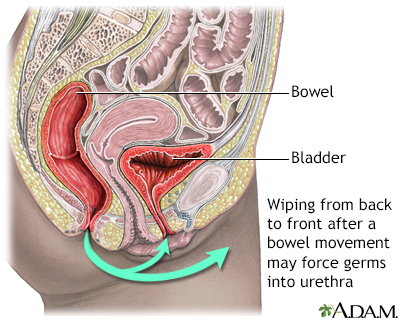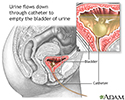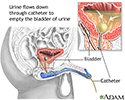Urinary tract infection - adults
Bladder infection - adults; UTI - adults; Cystitis - bacterial - adults; Pyelonephritis - adults; Kidney infection - adultsA urinary tract infection, or UTI, is an infection of the urinary tract. The infection can occur at different points in the urinary tract, including the:
-
Bladder -- An infection in the bladder is also called cystitis or a bladder infection.
Cystitis
Acute cystitis is an infection of the bladder or lower urinary tract. Acute means that the infection begins suddenly.
 ImageRead Article Now Book Mark Article
ImageRead Article Now Book Mark Article -
Kidneys -- An infection of one or both kidneys is called pyelonephritis or a kidney infection.
Pyelonephritis
Reflux nephropathy is a condition in which the kidneys are damaged by the backward flow of urine into the kidney.
 ImageRead Article Now Book Mark Article
ImageRead Article Now Book Mark Article - Ureters -- The tubes that take urine from each kidney to the bladder are rarely the only site of infection.
-
Urethra -- An infection of the tube that empties urine from the bladder to the outside is called urethritis.
Urethritis
Urethritis is inflammation (swelling and irritation) of the urethra. The urethra is the tube that carries urine from the body.
 ImageRead Article Now Book Mark Article
ImageRead Article Now Book Mark Article
Causes
Most UTIs are caused by bacteria that enter the urethra and then the bladder. The infection most commonly develops in the bladder, but can spread to the kidneys. Most of the time, your body can get rid of these bacteria. However, certain conditions increase the risk for having UTIs.
Women tend to get them more often because their urethra is shorter and closer to the anus than in men. Because of this, women are more likely to get an infection after sexual activity or when using a diaphragm for birth control. Menopause also increases the risk for a UTI.
The following also increase your chances of developing a UTI:
-
Diabetes
Diabetes
Diabetes is a long-term (chronic) disease in which the body cannot regulate the amount of sugar in the blood.
 ImageRead Article Now Book Mark Article
ImageRead Article Now Book Mark Article - Advanced age
- Conditions that affect personal care habits (such as Alzheimer disease and delirium)
Alzheimer disease
Dementia is a loss of brain function that occurs with certain diseases. Alzheimer disease (AD) is the most common form of dementia. It affects memo...
 ImageRead Article Now Book Mark Article
ImageRead Article Now Book Mark ArticleDelirium
Delirium is sudden severe confusion due to rapid changes in brain function that can occur with physical or mental illness.
 ImageRead Article Now Book Mark Article
ImageRead Article Now Book Mark Article - Problems emptying the bladder completely
-
Having a urinary catheter
Having a urinary catheter
A urinary catheter is a tube in your bladder that removes urine from the body. This tube may stay in place for an extended period of time. If so, i...
 ImageRead Article Now Book Mark Article
ImageRead Article Now Book Mark Article -
Bowel incontinence
Bowel incontinence
Bowel incontinence is the loss of bowel control, causing you to unexpectedly pass stool. This can range from sometimes leaking a small amount of sto...
 ImageRead Article Now Book Mark Article
ImageRead Article Now Book Mark Article -
Enlarged prostate, narrowed urethra, or anything that blocks the flow of urine
Enlarged prostate
The prostate is a gland that produces some of the fluid that carries sperm during ejaculation. The prostate gland surrounds the urethra, the tube th...
 ImageRead Article Now Book Mark Article
ImageRead Article Now Book Mark ArticleNarrowed urethra
Urethral stricture is an abnormal narrowing of the urethra. The urethra is the tube that carries urine out of the body from the bladder.
 ImageRead Article Now Book Mark Article
ImageRead Article Now Book Mark Article -
Kidney stones
Kidney stones
A kidney stone is a solid mass made up of tiny crystals. One or more stones can be in the kidney or ureter at the same time.
 ImageRead Article Now Book Mark Article
ImageRead Article Now Book Mark Article - Staying still (immobile) for a long period of time (for example, while you are recovering from a hip fracture)
- Pregnancy
- Surgery or other procedure involving the urinary tract
Symptoms
The symptoms of a bladder infection include:
-
Cloudy or bloody urine, which may have a foul or strong odor
Cloudy
Blood in your urine is called hematuria. The amount may be very small and only detected with urine tests or under a microscope. In other cases, the...
 ImageRead Article Now Book Mark Article
ImageRead Article Now Book Mark Article - Low grade fever in some people
- Pain or burning with urination
Urination
Painful urination is any pain, discomfort, or burning sensation when passing urine.
 ImageRead Article Now Book Mark Article
ImageRead Article Now Book Mark Article - Pressure or cramping in the lower abdomen or back
- Strong need to urinate often, even right after the bladder has been emptied
If the infection spreads to your kidneys, symptoms may include:
-
Chills and shaking or night sweats
Chills
Chills refers to feeling cold after being in a cold environment. The word can also refer to an episode of shivering along with paleness and feeling ...
 ImageRead Article Now Book Mark Article
ImageRead Article Now Book Mark Article -
Fatigue and a general ill feeling
Fatigue
Fatigue is a feeling of weariness, tiredness, or lack of energy.
 ImageRead Article Now Book Mark Article
ImageRead Article Now Book Mark Article - Fever above 101°F (38.3°C)
- Pain in the side, back, or groin
- Flushed, warm, or reddened skin
- Mental changes or confusion (in older people, these symptoms often are the only signs of a UTI)
Confusion
Confusion is the inability to think as clearly or quickly as you normally do. You may feel disoriented and have difficulty paying attention, remembe...
 ImageRead Article Now Book Mark Article
ImageRead Article Now Book Mark Article -
Nausea and vomiting
Nausea
Nausea is feeling an urge to vomit. It is often called "being sick to your stomach. "Vomiting or throwing-up forces the contents of the stomach up t...
 ImageRead Article Now Book Mark Article
ImageRead Article Now Book Mark Article - Severe abdominal pain (sometimes)
Exams and Tests
In many cases, you will need to provide a urine sample for the following tests:
-
Urinalysis -- This test is done to look for white blood cells, red blood cells, bacteria, and to test chemicals such as nitrites in the urine. This test can diagnose an infection most of the time.
Urinalysis
Urinalysis is the physical, chemical, and microscopic examination of urine. It involves a number of tests to detect and measure various compounds th...
 ImageRead Article Now Book Mark Article
ImageRead Article Now Book Mark Article -
Clean-catch urine culture -- This test may be done to identify the bacteria and determine the best antibiotic for treatment.
Clean-catch urine culture
A urine culture is a lab test to check for bacteria or other germs in a urine sample. It can be used to check for a urinary tract infection in adults...
 ImageRead Article Now Book Mark Article
ImageRead Article Now Book Mark Article
Blood tests such as complete blood count (CBC) and a blood culture may be done as well.
CBC
A complete blood count (CBC) test measures the following:The number of white blood cells (WBC count)The number of red blood cells (RBC count)The numb...

Blood culture
A blood culture is a laboratory test to check for bacteria or other germs in a blood sample.

You may also need the following tests to help check for other problems in your urinary system:
-
CT scan of the abdomen
CT scan of the abdomen
An abdominal CT scan is an imaging test that uses x-rays to create cross-sectional pictures of the belly area. CT stands for computed tomography....
 ImageRead Article Now Book Mark Article
ImageRead Article Now Book Mark Article -
Intravenous pyelogram (IVP)
Intravenous pyelogram
An intravenous pyelogram (IVP) is a special x-ray exam of the kidneys, bladder, and ureters (the tubes that carry urine from the kidneys to the bladd...
 ImageRead Article Now Book Mark Article
ImageRead Article Now Book Mark Article - Kidney ultrasound
-
Voiding cystourethrogram
Voiding cystourethrogram
A voiding cystourethrogram is an x-ray study of the bladder and urethra. It is done while the bladder is emptying.
 ImageRead Article Now Book Mark Article
ImageRead Article Now Book Mark Article
Treatment
Your health care provider must first decide if the infection is just in the bladder, or if it has spread to the kidneys and how severe it is.
MILD BLADDER AND KIDNEY INFECTIONS
- Most of the time, you will need to take an antibiotic to prevent the infection from spreading to the kidneys.
- For a simple bladder infection, you will take antibiotics for 1 to 5 days (women) or 7 to 14 days (men). The length of treatment depends on the antibiotic used.
- If you are pregnant or have diabetes, or have a mild kidney infection, you will most often take antibiotics for 7 to 14 days.
- Finish all of the antibiotics, even if you feel better. If you do not finish the whole dose of medicine, the infection may return and be harder to treat later.
- Always drink plenty of water when you have a bladder or kidney infection.
- Tell your provider if you might be pregnant before taking these medicines.
RECURRENT BLADDER INFECTIONS
Some women have repeated bladder infections. Your provider may suggest that you:
- Take a single dose of an antibiotic after sexual contact to prevent an infection.
- Have a 3 to 5 day course of antibiotics at home to use if you develop an infection.
- Take a single, daily dose of an antibiotic to prevent infections.
MORE SEVERE KIDNEY INFECTIONS
You may need to go into the hospital if you are very sick and cannot take medicines by mouth or drink enough fluids. You may also be admitted to the hospital if you:
- Are an older adult
- Have kidney stones or changes in the anatomy of your urinary tract
- Have recently had urinary tract surgery
- Have cancer, diabetes, multiple sclerosis, spinal cord injury, or other medical problems
Multiple sclerosis
Multiple sclerosis (MS) is an autoimmune disease that affects the brain and spinal cord (central nervous system).
 ImageRead Article Now Book Mark Article
ImageRead Article Now Book Mark Article - Are pregnant and have a fever or are otherwise ill
At the hospital, you will receive fluids and antibiotics through a vein.
Some people have UTIs that do not go away with treatment or keep coming back. These are called chronic UTIs. If you have a chronic UTI, you may need stronger antibiotics or to take medicine for a longer time.
You may need surgery if the infection is caused by a problem with the structure of the urinary tract.
Outlook (Prognosis)
Most UTIs can be cured. Bladder infection symptoms most often go away within 24 to 48 hours after treatment begins. If you have a kidney infection, it may take 1 week or longer for symptoms to go away.
Possible Complications
Complications may include:
- Life-threatening blood infection (sepsis) -- The risk is greater among the young, very old adults, and people whose bodies cannot fight infections (for example, due to HIV or cancer chemotherapy).
Sepsis
Sepsis is an illness in which the body has a severe, inflammatory response to bacteria or other germs.
 ImageRead Article Now Book Mark Article
ImageRead Article Now Book Mark Article - Kidney damage or scarring.
- Kidney infection.
When to Contact a Medical Professional
Contact your provider if you have symptoms of a UTI. Contact your provider right away if you have signs of a possible kidney infection, such as:
- Back or side pain
- Chills
- Fever
- Vomiting
Also contact your provider if UTI symptoms come back shortly after you have been treated with antibiotics.
Prevention
Diet and lifestyle changes may help prevent some UTIs. After menopause, a woman may use estrogen cream around the vagina to reduce infections.
Lifestyle changes
Most urinary tract infections (UTIs) are caused by bacteria that enter the urethra and travel to the bladder.
Read Article Now Book Mark Article
References
Cooper KL, Badalato GM, Rutman MP. Infections of the urinary tract. In: Partin AW, Dmochowski RR, Kavoussi LR, Peters CA, eds. Campbell-Walsh-Wein Urology. 12th ed. Philadelphia, PA: Elsevier; 2021:chap 55.
Drekonja D. Approach to the patient with urinary tract infection. In: Goldman L, Cooney KA, eds. Goldman-Cecil Medicine. 27th ed. Philadelphia, PA: Elsevier; 2024:chap 263.
Sobel JD, Brown P. Urinary tract infections. In: Bennett JE, Dolin R, Blaser MJ, eds. Mandell, Douglas, and Bennett's Principles and Practice of Infectious Diseases. 9th ed. Philadelphia, PA: Elsevier; 2020:chap 72.
-
Bladder catheterization - female - illustration
A catheter (a hollow tube, often with an inflatable balloon tip) may be inserted into the urinary bladder when there is a urinary obstruction, following surgical procedures to the urethra, in unconscious patients (due to surgical anesthesia, coma, or other reasons), or for any other problem in which the bladder needs to be kept empty (decompressed) and urinary flow assured. The balloon holds the catheter in place for a duration of time.
Bladder catheterization - female
illustration
-
Bladder catheterization - male - illustration
Catheterization is accomplished by inserting a catheter (a hollow tube, often with and inflatable balloon tip) into the urinary bladder. This procedure is performed for urinary obstruction, following surgical procedures to the urethra, in unconscious patients (due to surgical anesthesia, coma, or other reasons), or for any other problem in which the bladder needs to be kept empty (decompressed) and urinary flow assured. The balloon holds the catheter in place for a duration of time. Catheterization in males is slightly more difficult and uncomfortable than in females because of the longer urethra.
Bladder catheterization - male
illustration
-
Female urinary tract - illustration
The female and male urinary tracts are relatively the same except for the length of the urethra.
Female urinary tract
illustration
-
Male urinary tract - illustration
The male and female urinary tracts are relatively the same except for the length of the urethra.
Male urinary tract
illustration
-
Prevention of cystitis - illustration
Appropriate hygiene and cleanliness of the genital area may help reduce the chances of introducing bacteria through the urethra. Females are especially vulnerable to this, because the urethra is in close proximity to the rectum. The genitals should be cleaned and wiped from front to back to reduce the chance of dragging E. coli bacteria from the rectal area to the urethra.
Prevention of cystitis
illustration
-
Bladder catheterization - female - illustration
A catheter (a hollow tube, often with an inflatable balloon tip) may be inserted into the urinary bladder when there is a urinary obstruction, following surgical procedures to the urethra, in unconscious patients (due to surgical anesthesia, coma, or other reasons), or for any other problem in which the bladder needs to be kept empty (decompressed) and urinary flow assured. The balloon holds the catheter in place for a duration of time.
Bladder catheterization - female
illustration
-
Bladder catheterization - male - illustration
Catheterization is accomplished by inserting a catheter (a hollow tube, often with and inflatable balloon tip) into the urinary bladder. This procedure is performed for urinary obstruction, following surgical procedures to the urethra, in unconscious patients (due to surgical anesthesia, coma, or other reasons), or for any other problem in which the bladder needs to be kept empty (decompressed) and urinary flow assured. The balloon holds the catheter in place for a duration of time. Catheterization in males is slightly more difficult and uncomfortable than in females because of the longer urethra.
Bladder catheterization - male
illustration
-
Female urinary tract - illustration
The female and male urinary tracts are relatively the same except for the length of the urethra.
Female urinary tract
illustration
-
Male urinary tract - illustration
The male and female urinary tracts are relatively the same except for the length of the urethra.
Male urinary tract
illustration
-
Prevention of cystitis - illustration
Appropriate hygiene and cleanliness of the genital area may help reduce the chances of introducing bacteria through the urethra. Females are especially vulnerable to this, because the urethra is in close proximity to the rectum. The genitals should be cleaned and wiped from front to back to reduce the chance of dragging E. coli bacteria from the rectal area to the urethra.
Prevention of cystitis
illustration
-
Urinary tract infection - InDepth
(In-Depth)
-
Urinary tract infection in women
(Alt. Medicine)
-
Urinary incontinence - InDepth
(In-Depth)
-
Kidney stones - InDepth
(In-Depth)
-
Benign prostatic hyperplasia
(Alt. Medicine)
-
Herpes simplex - InDepth
(In-Depth)
-
Gallstones and gallbladder disease - InDepth
(In-Depth)
-
Diabetes - type 2 - InDepth
(In-Depth)
-
Crohn disease - InDepth
(In-Depth)
-
Epilepsy - InDepth
(In-Depth)
Review Date: 7/23/2024
Reviewed By: Linda J. Vorvick, MD, Clinical Professor, Department of Family Medicine, UW Medicine, School of Medicine, University of Washington, Seattle, WA. Also reviewed by David C. Dugdale, MD, Medical Director, Brenda Conaway, Editorial Director, and the A.D.A.M. Editorial team.








